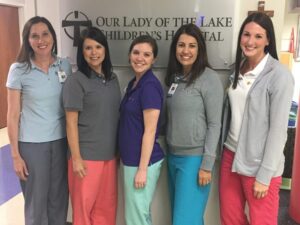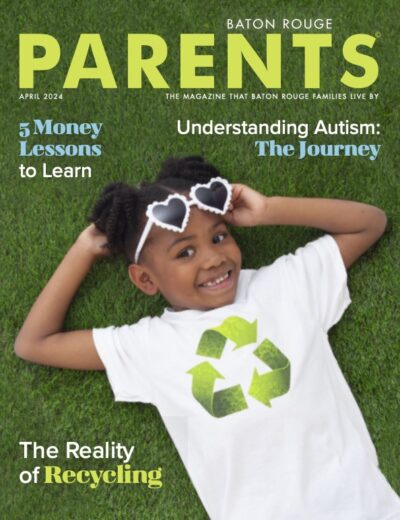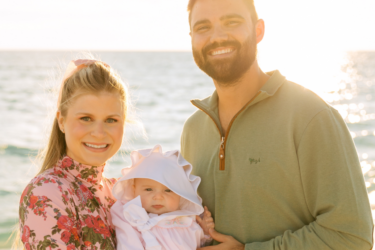
Our Lady of the Lake Children’s Hospital Child Life Specialists
Hospitals can be intimidating and terrifying places, especially for children. At Our Lady of the Lake Children’s Hospital, 10 special people work their hardest to assure that the hospital can be a positive experience with even some fun and good memories. These magicians who transform the frightening into the familiar are the certified child life specialists. They operate as medical translators, therapists, and teachers all in one day.
“When I introduce my services, I usually just start by saying I make it easier to be here. We know that nobody wants to be in the hospital. This isn’t what people plan. But we are here to try to make it comfortable and help the families cope with being here,” says Maddie Dumas, the Hematology/Oncology child life specialist.
Certified child life specialists make the hospital experience easier by delivering education, preparation, and support for patients and their families. Whether they are helping children understand their illnesses in developmentally-appropriate ways, calming their fears during medical procedures, or assisting families in coping with difficult events, they make a stressful situation more manageable. Child life specialists can be found in the Pediatric ER, the Pediatric Intensive Care Unit, the Pediatric Hematology/Oncology Unit, the St. Jude Clinic, and the General Pediatric Unit. “We all have the same goal and same mission, but we happen to work in specialty areas,” says Sharon Wesberry, the Child Life Manager and specialist for the PICU.
One significant duty is translating a diagnosis or a procedure from medical speak to age-appropriate language. “Every case is different. We could be describing something to a 3 year old or a 13 year old. We are trained to know how to talk to each of those kids based on their developmental level,” Dana Achary, Surgical Specialist, shares. The child life specialists meet with physicians and nurses before they speak to the child to discuss the diagnosis and make sure they understand it correctly. Dumas explains their role, “We need to be the safe person. Sometimes the doctor comes in and the patient or parents forget what they are going to ask or the nurse comes in and the child hides. It’s nothing against that staff person, but it’s just that the child understands they come with medicine or a shot, and we bring a puzzle and toys, so it’s easier to talk to us. We get to be that go-between for the family and the medical staff. I do a lot of new diagnosis teaching, so if we have a patient come in who gets diagnosed with cancer, I help them comprehend what that means in words they understand.”
In addition to diagnosis education, child life specialists also prepare their little patients for surgeries and procedures. Both Achary and Amy Enos spend their time in Pre-Op and the OR with their patients. “Whenever we are providing any preparation for procedures, I always explain to the parents why it’s important that the kids understand what’s happening and how it’s beneficial to them. If I did something for the very first time, I would like somebody to tell me what’s going to happen and what to expect so there are no surprises. We all feel less anxious if we have some idea of what to expect,” Enos explain. Before the children go back into surgery, Achary and Enos first build rapport and trust with the patients, clearly articulate what will happen, and then walk them through everything they’re going to see. They explain the IV, the induction mask, the EKG leads, the pulse sox, and the blood pressure cuff, and normalize them by letting the kids play with the devices. “Most of the kids freak out with the induction mask, so we normalize it by letting them pick a flavor for it, decorate it with stickers, or call it a Darth Vader mask,” Achary says. The specialists also go to the OR with their patients and use distraction techniques like an iPad, an I Spy book, or a light-up toy until they fall asleep. Preparation then turns into providing comfort.
Through games, toys, books, arts and crafts, and a playroom, child life specialists bring comfort to their patients. “We provide opportunities for play in the hospital environment whether that’s bringing a child down to the playroom or bringing toys to them. Play is how kids learn, develop, problem solve, and express themselves,” Enos shares. In the St. Jude Clinic, Morgan Covington tries to normalize the clinic and procedures as much as possible. This includes the usual activities like Play-Doh, arts-and-craft supplies, and stocking the playroom with fun toys and electronics like Xboxes and iPads. She also includes “medical supplies (syringes, gauze, band-aids, etc.) for hands-on art projects to allow kids to become familiar and more comfortable with these items.” Sometimes the specialists do such a good job, children are even disappointed when they leave. Wesberry says, “Some kids don’t want to go home because of the experience we made for them. We offer rewards, incentives, time and attention.”
Child life specialists are not just patient-centered, however. They focus on the whole family: the patient, parents, and siblings. Child life specialists build strong relationships with the parents and advocate on their behalf. In the PICU, “Family care goes on in there, because often the patient may be on a ventilator. So it’s a lot of parent support and sibling support, helping them cope with what’s going on,” Wesberry describes. The child life specialists’ reach goes beyond the Children’s Hospital. Wesberry continues, “We often get consults from the adult areas when there is a parent or grandparent typically at the end of life. We will go in, offer support, and work with the family on how to explain to the children involved that their loved one will pass away, or is critically ill, or has had a stroke, or paralysis.”
Child life specialists are a true team, covering one another and comforting one another whenever needed. They rely on each other because many children pass through different sections of the Children’s Hospital. Patty Prentice, the ER specialist, will leave long voicemails for the other child life specialists about children transitioning from the ER into their care, notifying her co-workers of each unique need. Wesberry emphasizes, “We all cross cover each other, so that’s an opportunity to have that comfort and support from each other.” These seasoned professionals also work with aspiring child life specialists. This profession is a highly competitive field, and OLOL Children’s Hospital is 1 of 33 hospitals worldwide accredited for child life specialist internships. Not only are these 10 women doing great work, but they are also training the next child life specialists to be outstanding as well.
The OLOL Children’s Hospital child life specialists are here to serve. “I’ve been a child life specialist for 21 years, and I absolutely love what I do. I am enriched each day. I never know what my day is going to be like. There are some days that I do arts and crafts and I play games and have fun. And there are other days when I step away and have to shed a few tears. I never want to have to stand in the position of what some of these families have to go through, but if I did, I would want to have our team there,” Wesberry shares. ■





